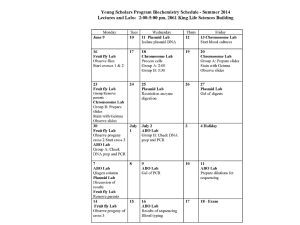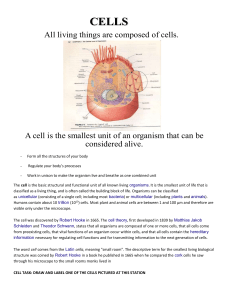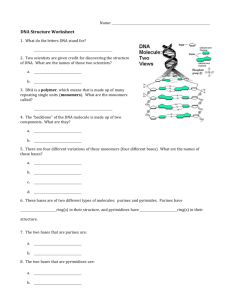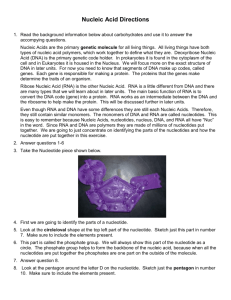DNA Structure Reading - High School Science Help
advertisement
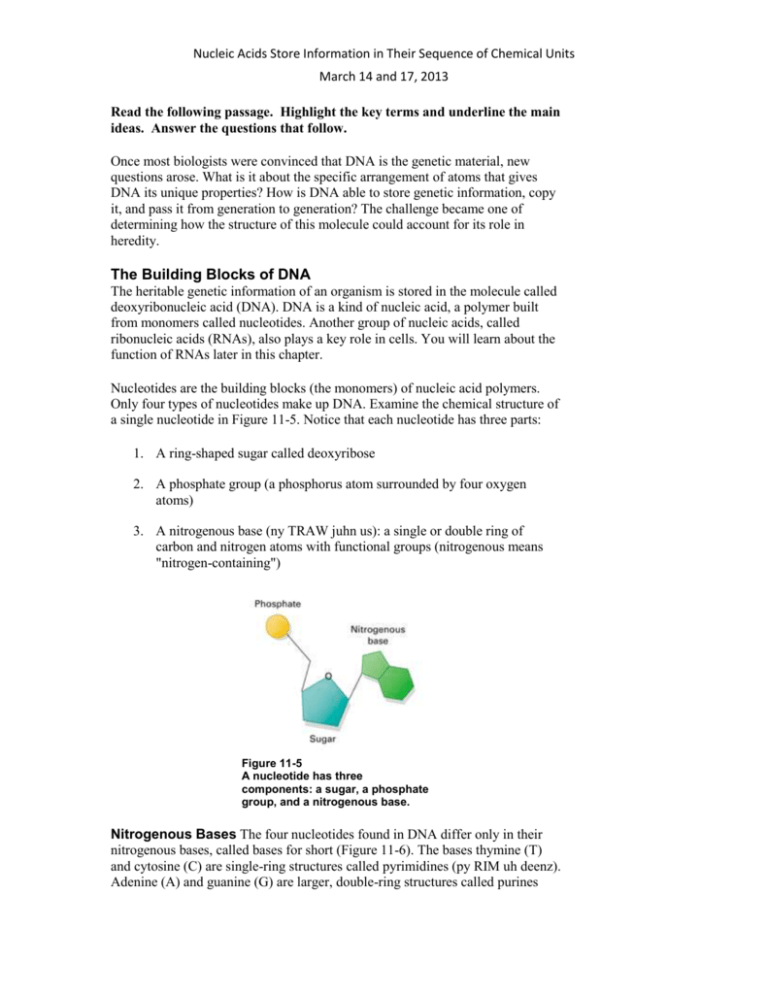
Nucleic Acids Store Information in Their Sequence of Chemical Units March 14 and 17, 2013 Read the following passage. Highlight the key terms and underline the main ideas. Answer the questions that follow. Once most biologists were convinced that DNA is the genetic material, new questions arose. What is it about the specific arrangement of atoms that gives DNA its unique properties? How is DNA able to store genetic information, copy it, and pass it from generation to generation? The challenge became one of determining how the structure of this molecule could account for its role in heredity. The Building Blocks of DNA The heritable genetic information of an organism is stored in the molecule called deoxyribonucleic acid (DNA). DNA is a kind of nucleic acid, a polymer built from monomers called nucleotides. Another group of nucleic acids, called ribonucleic acids (RNAs), also plays a key role in cells. You will learn about the function of RNAs later in this chapter. Nucleotides are the building blocks (the monomers) of nucleic acid polymers. Only four types of nucleotides make up DNA. Examine the chemical structure of a single nucleotide in Figure 11-5. Notice that each nucleotide has three parts: 1. A ring-shaped sugar called deoxyribose 2. A phosphate group (a phosphorus atom surrounded by four oxygen atoms) 3. A nitrogenous base (ny TRAW juhn us): a single or double ring of carbon and nitrogen atoms with functional groups (nitrogenous means "nitrogen-containing") Figure 11-5 A nucleotide has three components: a sugar, a phosphate group, and a nitrogenous base. Nitrogenous Bases The four nucleotides found in DNA differ only in their nitrogenous bases, called bases for short (Figure 11-6). The bases thymine (T) and cytosine (C) are single-ring structures called pyrimidines (py RIM uh deenz). Adenine (A) and guanine (G) are larger, double-ring structures called purines Nucleic Acids Store Information in Their Sequence of Chemical Units March 14 and 17, 2013 (PYOOR eenz). The one-letter abbreviations stand for both the bases alone and for the nucleotides containing them. DNA Strands Nucleotides are joined to one another by covalent bonds that connect the sugar of one nucleotide to the phosphate group of the next. This repeating pattern of sugar-phosphate-sugar-phosphate is called a sugar-phosphate "backbone." The nitrogenous bases are lined up along this backbone (Figure 117). Figure 11-6 DNA contains four different nitrogenous bases. Thymine and cytosine have single-ring structures. Adenine and guanine have double-ring structures. Just as amino acid monomers combine and form a polypeptide, the nucleotides of a nucleic acid polymer can combine in many different sequences. For example, the part of a nucleic acid shown in Figure 11-7 has nine nucleotides arranged in the order CTGCTATCG. This arrangement is only one of many possible. Since nucleotide chains also vary in length, from only a few hundred nucleotides to millions of nucleotides, the number of possible nucleotide sequences is essentially unlimited. Nucleic Acids Store Information in Their Sequence of Chemical Units March 14 and 17, 2013 Figure 11-7 Nucleotide monomers join together by covalent bonds between the sugar of one nucleotide and the phosphate of the next, forming a sugar-phosphate backbone. For years, people wondered how strings of nucleotides could serve as the hereditary material. As you will read next, it turns out that a string of nucleotides is just one key feature of DNA's structure. DNA's Structure In the early 1950s, scientists Rosalind Franklin and Maurice Wilkins produced some intriguing photographs of DNA using a method called X-ray crystallography. This technique provides clues to the shapes and dimensions of complex molecules. The photographs showed the basic shape of DNA to be a helix, and revealed the basic dimensions of the helix. The Double Helix Meanwhile, scientists James Watson and Francis Crick modeled DNA's structure with tin and wire. Their early models failed to explain DNA's chemical properties. Then one day, Watson saw one of Franklin's X-ray crystallography photos of DNA. Using the clues provided by Franklin's work, Watson and Crick created a new model in which two strands of nucleotides wound about each other. This formed a twisting shape called a double helix (Figure 11-8). Their model placed the sugar-phosphate backbones on the outside of the double helix and the nitrogenous bases on the inside. They hypothesized that the nitrogenous bases that aligned across the two strands formed hydrogen bonds. This new model successfully represented DNA's structure. Nucleic Acids Store Information in Their Sequence of Chemical Units March 14 and 17, 2013 Figure 11-8 The bases pair up between the two intertwined sugarphosphate backbones, forming the double helix discovered by Watson and Crick. A pairs with T, and G pairs with C. Complementary Base Pairs Watson and Crick realized that the individual structures of the nitrogenous bases determine very specific pairings between the nucleotides of the two strands of the double helix. These pairings are due to the sizes of the bases and their abilities to form hydrogen bonds with each other. The purine adenine pairs with the pyrimidine thymine, and the purine guanine pairs with the pyrimidine cytosine. In the biologist's shorthand, A pairs with T, and G pairs with C. A is also said to be "complementary" to T, and G is complementary to C. So, while the sequence of nucleotides along the length of one of the two DNA strands can vary in countless ways, the bases on the second strand of the double helix are determined by the sequence of the bases on the first strand. Each base must pair up with its complementary base. Base-pairing rules set the stage for understanding how the information in DNA is passed through generations. In 1953, Watson and Crick described their model in a two-page article in the science journal Nature. Few milestones in the history of biology have been as important as the discovery of the double helix and the pairing of complementary bases. Concept Check 1. What are the three parts of a nucleotide? Which parts make up the backbone of a DNA strand? 2. List the two base pairs found in DNA. 3. If six bases on one strand of a DNA double helix are AGTCGG, what are the six bases on the complementary section of the other strand of DNA?


